Podcast: Play in new window | Download (Duration: 21:56 — 22.5MB)
It’s mystery ape time! Learn about de Loys’ ape and two other mystery apes this week!
The only photograph we have of de Loys’ ape:
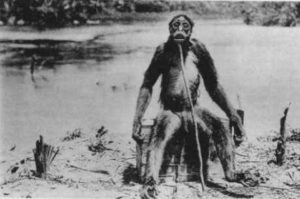
A white-fronted spider monkey:

Oliver the so-called “ape man”:

A better picture of Oliver late in his life:
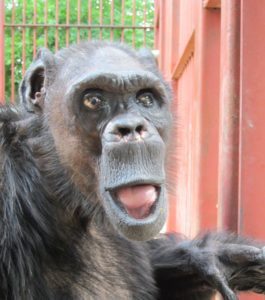
A Bili ape:
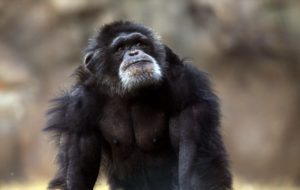
A regular gorilla (top) and a regular chimp (bottom, hearing no evil) for comparison with the Bili ape and Oliver:
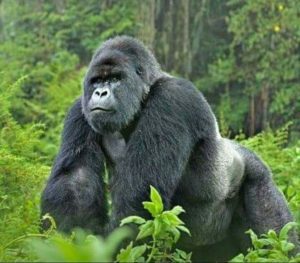
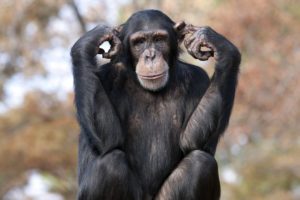
Show transcript:
Welcome to Strange Animals Podcast. I’m your host, Kate Shaw.
I don’t know about you, but I’m in the mood for a mystery animal this week. So let’s really dig in to a topic I haven’t covered much before, mystery apes!
A lot of people get apes and monkeys confused, but it’s actually easy to tell them apart. For one thing, there aren’t very many apes. Gorillas, chimpanzees, orangutans, and bonobos are called great apes, and gibbons and siamangs are called the lesser apes, mostly because they’re smaller.
Apes never have tails and are closely related to humans. Humans, in fact, are considered great apes, but it’s rude to say so. We like to think we’re special because we can make podcasts and bulldozers and delicious cakes. Monkeys usually have tails, although not always, and a monkey, unlike an ape, can’t stand fully upright and can’t straighten its elbow out so that its arm is flat.
Now that we have a pretty good idea of what an ape is, let’s look at three mystery apes.
We’ll start with a big mystery from 1920, an ape supposedly killed in South America and subsequently dubbed de Loys’ ape. It’s not just one mystery, it’s several mysteries wrapped up together. And while the ape’s body has been lost, we still have a photograph.
In 1917, geologist François de Loys led an expedition to Venezuela and Colombia to search for oil. It was a disaster of an expedition, since not only did they not find oil, almost everyone in the expedition died. According to de Loys, in 1920 what was left of the group was camped along the Tarra River on the border between Colombia and Venezuela when two large animals appeared. De Loys said he thought they were bears at first, then realized they were apes of some kind. They were large, had reddish hair and no tails, and walked upright. The apes became aggressive toward the humans and, fearing for their lives, the geologists shot at the apes. They killed one and wounded the other, which fled.
The dead ape looked like a spider monkey, which was fairly common in the area, but it was much larger and had no tail. There was no way for the expedition to keep the body, so they propped it up on a crate with a stick under its chin to keep it upright, then took pictures. Only one of those pictures survived, since de Loys said the others were lost when a boat capsized later in the expedition.
But after de Loys got home to Europe, he didn’t tell anyone about the ape. He said he forgot all about it until 1929 when the anthropologist George Montandon noticed the surviving photograph in de Loys’s papers. After that, De Loys wrote an article about the ape which was published in the Illustrated London News.
It was a sensational article, not meant to be scientific. Here’s an excerpt:
“The jungle swished open, and a huge, dark, hairy body appeared out of the undergrowth, standing up clumsily, shaking with rage, grunting and roaring and panting as he came out onto us at the edge of the clearing. The sight was terrifying…
“The beast jumped about in a frenzy, shrieking loudly and beating frantically his hairy chest with his own fists; then he wrenched off at one snap a limb of a tree and, wielding it as a man would a bludgeon, murderously made for me. I had to shoot.”
Montandon was enthusiastic about the ape. He wrote three articles for scientific journals and proposed the name Ameranthropoides loysi for it. But scientists were skeptical. Who was this de Loys guy and did he have any proof that the ape wasn’t just a spider monkey? Did he even have proof that the photograph was taken in South America?
Because that’s one of the mysteries. Quite apart from what kind of primate de Loys’ ape might be, if it really is an ape, is it an ape native to South America? There are no apes native to the Americas at all, only monkeys. Chimpanzees, gorillas, and bonobos live in Africa, while orangutans, gibbons, and siamangs live in Asia. If de Loys really did find an ape new to science in South America, it radically changes what we know about ape evolution.
De Loys said he measured the animal as 157 cm high, which works out to about 4.5 feet. This is much larger than a spider monkey, which tops out at about 3.5 feet high, or 110 cm. But we have only de Loys’s word to go by, and as it happens, de Loys was a known practical joker. He also didn’t talk about the ape very often and seems to have only written his article at the urging of Montandon, his friend the anthropologist. We’ll come back to Montandon in a minute.
In 1962, a medical doctor, Enrique Tejera, read an article about de Loys’ ape in a magazine called The Universal. Tejera had worked with de Loys during part of his expedition as a camp doctor, and he had firsthand knowledge about de Loys’ ape. The letter was published, and published again in 1999 in the Venezuelan scientific magazine Interciencia. I’ll read an excerpt of the translated letter:
“This monkey is a myth. I will tell you his story. Mister Montandon said that the monkey had no tail. That is for sure, but he forgot to mention something: it has no tail because it was cut off. I can assure you, gentlemen, because I saw the amputation. In 1917 I was working in a camp for oil exploration in the region of Perijá. The geologist was François de Loys and the engineer Dr. Martín Tovar Lange. De Loys was a prankster and often we laughed at his jokes. One day they gave him a monkey with an infected tail, so it was amputated. After that de Loys called him ‘el hombre mono,’ the monkey man.
“Some time later de Loys and I entered another region of Venezuela, an area called Mene Grande. He always took his monkey along, who died some time later [in 1919]. De Loys decided to take a photo and I believe that Mr. Montandon will not deny it is the same photograph that he presented in 1929.”
The monkey Dr. Tejera said de Loys had been given was a white-fronted spider monkey. And that’s exactly what the photo de Loys took looks like.
I’ll put the photo of de Loys’ ape in the show notes if you want to look at it. There are no people in the photo, nothing except the crate it’s sitting on to use as a size reference. You can’t even see whether the animal has a tail or not.
The white-fronted spider monkey is endangered these days due to habitat loss and hunting, but in the early 20th century it was still common in Colombia, Venezuela, and other parts of northwestern South America. It’s mostly black with a white belly, a long tail, and long arms and legs. That’s why they’re called spider monkeys, incidentally. Long arms and legs like a spider. The white-fronted spider monkey mostly eats fruit, but it also eats leaves, flowers, and other plant parts, and occasionally eats insects. Like many monkeys, its tail is somewhat prehensile and has a bare patch near the end that helps it grip branches like an extra finger. Since the spider monkey doesn’t have actual thumbs on its hands like most primates, it needs that tail to help it get around in trees.
If you look closely at the photograph of de Loys’ ape, you can see that the poor dead monkey does not have thumbs on its hands the way an ape would. It also looks like it has a penis, but that’s actually not a penis. Female spider monkeys have an organ that retains droplets of urine and drips them out as the monkey travels around, leaving a scent trail, and which looks superficially like a penis. It’s actually called a pseudo-penis and it makes it difficult for researchers to determine whether a spider monkey in the wild is male or female at first glance. It’s also an organ only found in spider monkeys and a few other types of monkey, never apes.
So we can be pretty sure de Loys’ ape was actually a spider monkey. But there’s more going on here than a simple hoax. Here’s another excerpt from de Loys’s 1929 article. He writes,
“Until my discovery of the American anthropoid, we could only imagine that man migrated to these shores. But now, in the light of this discovery, it is obvious that the failure of the otherwise well established principle of evolution when it was applied to America was due only to imperfect knowledge. The gap observed in America between monkey and man has been eliminated; the discovery of the Ameranthropoid has filled it.”
What? WHAT? What is that mess of a paragraph trying to say?
Well, basically, it’s promoting Montandon’s theory that humans of different races evolved from different apes. We know these days that that’s nonsense. All humans are genetically the same species, despite superficial physical differences like skin and hair color. Montandon thought that, for instance, people from Africa had evolved from gorillas, Asians evolved from orangutans, while people from Europe—you know, white people—were the only ones actually descended from early Homo sapiens.
In other words, Montandon wasn’t just a terrible scientist, he was a terrible human being, because his theory was pure racism. He was delighted to learn about de Loys’ ape because he decided that was the ape that native Americans must have evolved from. Again, nonsense science, awful person, I’m glad he’s dead. The French Resistance killed him during WWII.
It’s possible that de Loys wasn’t even trying to hoax anyone initially. He just had a pet monkey that died, took a photo as a creepy joke, and stuck the photo in his papers. It was Montandon who came across the photo and urged de Loys to write about it. It’s very likely that Montandon decided to claim the animal was an ape to further his racist theory, and de Loys went along with it, possibly reluctantly given how little he talked about it.
Ugh. Let’s move on to something less infuriating.
Oliver was a strange-looking chimpanzee sometimes referred to as an ape-man back in the 1970s. Oliver had been part of a traveling animal act, but he never fit in with the other chimps in the act and preferred to spend his time with humans, helping with chores. He walked fully upright at all times.
In 1976 an attorney called Michael Miller bought Oliver, mostly because Oliver just looked weird. His head was oddly shaped compared to other chimps and his jaw was smaller and more human-like in appearance. His ears were slightly pointed. The popular press found Oliver interesting and for a short while he was famous, or infamous. Some claims about Oliver were that he had 47 chromosomes instead of a chimp’s normal 48, that he was a mutant, that he was a hybrid between a chimp and some other primate, like a bonobo, or even an ape-man somewhere between a human and a chimp.
Oliver had a rough life, honestly. Michael Miller sold him to a theme park in 1977, and after that Oliver was passed from theme park to theme park. Interest in Oliver died down after a while, and in 1989, he was bought by a laboratory that leased out animals for testing. Oliver was never used as an experimental animal, but he lived for seven years in a cage so small he could barely move, so that his muscles atrophied.
Fortunately, in 1996 Oliver finally got a break and moved to an animal sanctuary in Texas. He had a spacious territory of his own, a chimp mate called Raisin, and lived out the rest of his days in peace. He died in 2012 at the age of about 55.
When the sanctuary acquired Oliver, they had him genetically tested to see if he really was a hybrid animal. It turned out that Oliver’s chromosome count was normal for a chimpanzee, and that he was genetically dead normal in every respect. So why did he look so weird?
Mainly, it was because his teeth had all been pulled at an early age so he couldn’t bite. This barbaric practice resulted in his jaw muscles being underdeveloped and his jaw bones becoming shortened. His head and ear shape were well within normal range for chimps, but only looked strange when combined with his poorly developed jaw. And the reason he walked upright all the time was because he’d been trained to do so.
After Oliver died, the sanctuary cremated his body and spread his ashes on the grounds where he had lived peacefully for the first time in his life.
Our last mystery ape this week is called the Bili ape. In 1898, a Belgian army officer donated some skulls to a museum in Belgium, skulls which he said were from gorillas killed in what is now the Democratic Republic of Congo. Specifically, he said the gorillas lived in a forest near the village of Bili in an area referred to as Bondo. So after a museum curator examined the skulls and realized they weren’t the same as other gorilla skulls and not from an area where gorillas were known to live, the mystery ape was dubbed the Bili ape or the Bondo ape. The curator thought the Bili ape was a subspecies of gorilla.
In 1970 a mammalogist examined the skulls and determined that they were just regular old western lowland gorilla skulls. Nothing exciting. But a conservationist and photographer named Karl Ammann wasn’t convinced. He decided to go out and see if he could find the Bili ape for himself, take pictures, and see what the ape really was. In 1996, he took his cameras and went looking for gorillas.
He didn’t find any, but he did find a skull. It looked sort of like a gorilla skull, which has what’s called a sagittal crest that runs along the top of the skull and which allows the attachment of a gorilla’s powerful jaw muscles. But the rest of the skull looked more like a chimpanzee’s. Ammann also bought a photograph taken from a poacher’s trail cam that showed what looked like huge chimps. He also found great big poops and great big footprints, larger even than a gorilla’s footprint.
He had enough evidence to interest researchers, so in 2001 he and a team of scientists returned to find the Bili ape. They had no luck, partly because there was a civil war going on in the area at the time and getting around without getting killed was difficult. But they did find evidence that the apes were there, and the evidence was confusing. Gorillas build nests on the ground to sleep in, and the team did find big nests on the ground. But gorillas don’t like swampy ground and they move around a lot and build a new nest every night. These nests were often in swampy areas and showed evidence that they were reused. Chimps prefer to sleep in trees. But while the feces the researchers collected from around the nests were big enough to be gorilla poops, they indicated the apes’ diet was high in fruit, which is typical of chimps.
The team returned to the area in 2003 after the civil war ended, and this time they found the Bili ape.
The first scientist to see a Bili ape was a primate behavior specialist named Shelly Williams. The whole group heard the apes in the trees around them, very close to them, and then four apes rushed at the group. Williams knew they weren’t trying to intimidate the humans, they were going to kill them—I mean, that’s what it means to be a primate behavior specialist. It apparently means you know when you’re about to die at the hands of an enraged mystery ape. But the apes caught sight of her, stopped short, and returned into the brush.
If that happened to me, for one thing I would wet myself, and for another I would wonder for the rest of my life if I was an extra pretty human, or if I was extra pretty for a chimp or gorilla. But as it happens, Williams knew that the apes weren’t after the humans specifically but had responded to a call made by the team’s tracker, who had imitated the noise a wounded antelope makes. Imagine the scene from the apes’ point of view. You’re out hunting with your buddies, you hear some loud noises of animals walking through the forest. Then you hear an antelope. You and your buddies rush out, already thinking about how good that antelope is going to taste—and instead of antelopes, you see a bunch of humans. Of course you’re going to beat feet, because those humans might be hunting you.
Williams was the only scientist in the group to get a look at the apes that day, and they confused her. They mostly looked like chimps, but they were huge. A male common chimpanzee is about five feet tall when standing, or 1.5 meters, with females usually about a foot shorter, or 30 cm shorter. The Bili ape was way bigger, closer to six feet tall, or 1.8 meters. This is the height of a gorilla. Williams wasn’t sure if she’d seen giant chimps or weird gorillas or something else entirely.
After that first sighting, the team was able to get video and photos of the Bili apes. They resemble large chimps with gorilla-like heads, and Williams thinks the females and young mostly sleep in trees, while adult males sleep on the ground. They seem to live and travel in small groups, compared to chimps that usually live in troupes of up to 50 members.
The locals in the area say there are two different kinds of Bili ape. The smaller ones prefer to live in trees and are known as tree-beaters. The larger ones live on the ground and are called lion-killers. The lion-killers are supposed to be immune to the poison-dart frog secretions that locals use to poison their arrow tips.
DNA samples from dung and hair finally cleared up the mystery. Results indicate that the apes are chimpanzees, specifically a known subspecies of the common chimpanzee. Researchers think the Bili ape may look and act different since it’s so isolated from other chimps and may be somewhat inbred. Bili apes encountered far from villages show very little fear or aggression toward humans, only curiosity. Unfortunately, the chimps are under increased threat from poaching, since gold mining began in the area in 2007 and the population of humans has increased. Hopefully protections can be put into place soon so these rare chimpanzees can remain safely in their homes and can continue to be studied by researchers.
One exciting thing to remember is that the area where the Bili ape lives is still quite remote. There could very well be other animals unknown to science hidden in the forests. That’s yet another reason to protect the forest and everything that lives in it. You never know what might be out there ready to be discovered.
You can find Strange Animals Podcast online at strangeanimalspodcast.com. We’re on Twitter at strangebeasties and have a facebook page at facebook.com/strangeanimalspodcast. If you have questions, comments, or suggestions for future episodes, email us at strangeanimalspodcast@gmail.com. We also have a Patreon if you’d like to support us that way.
Thanks for listening!